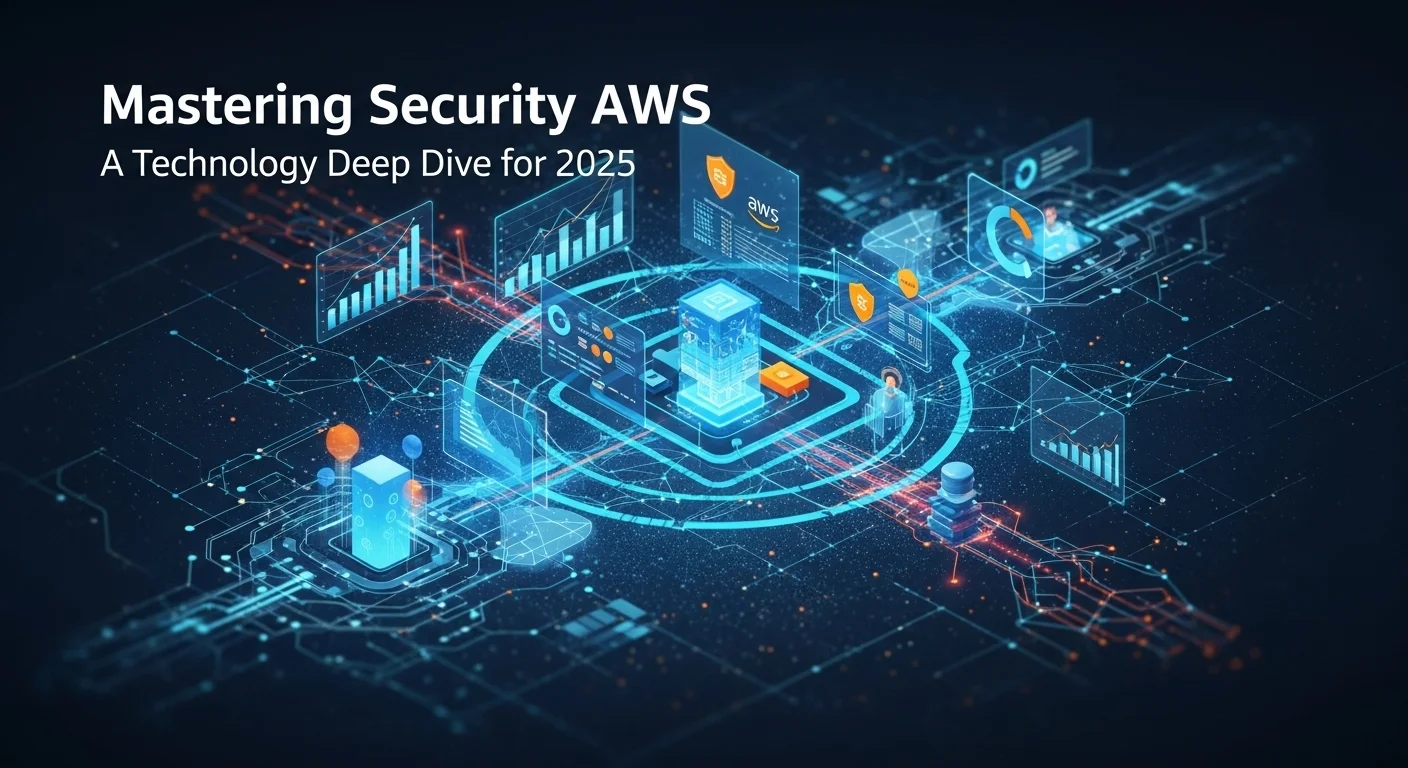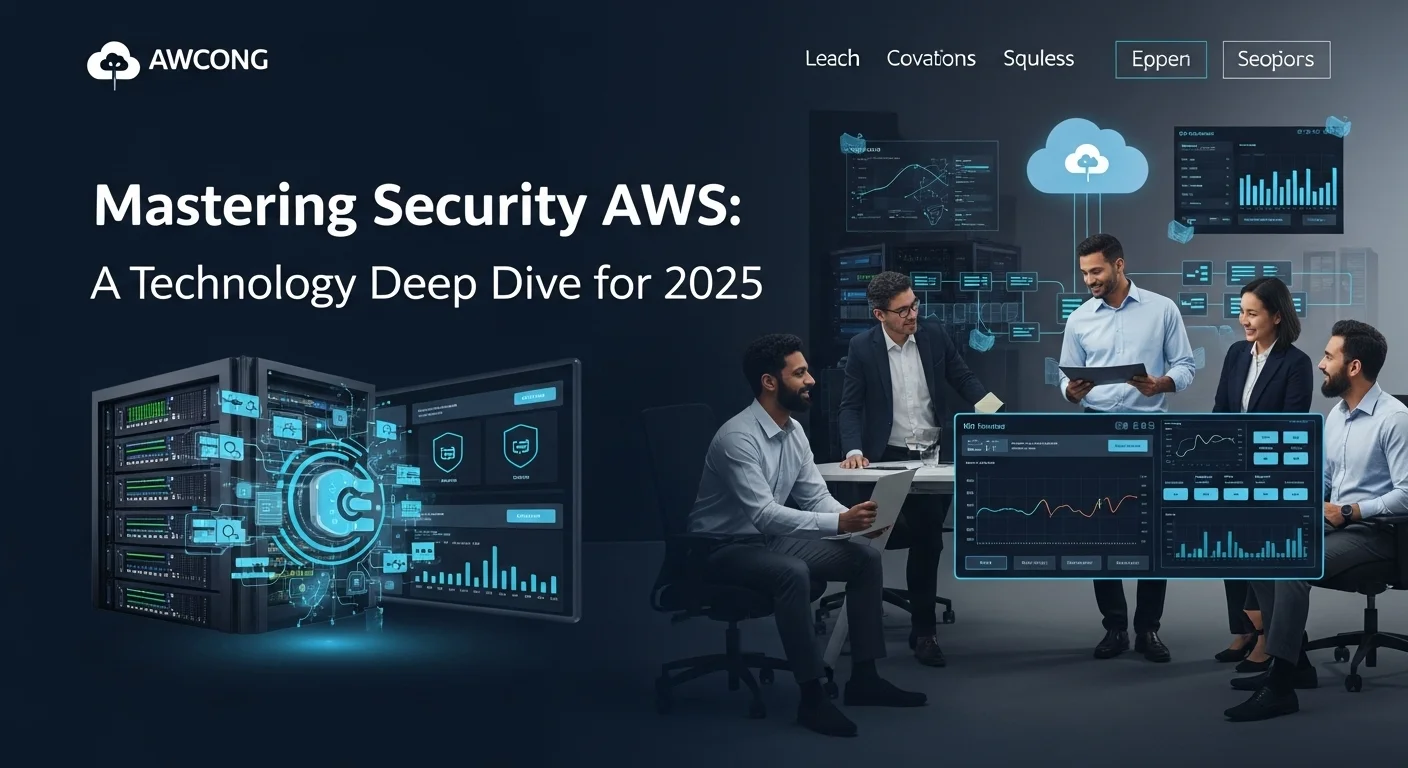Your 2025 Guide to AWS Security: Protecting Your Business in the Cloud

Executive Summary
Moving your business to the cloud is an exciting step. It promises speed, scalability, and innovation. But I've seen that excitement turn into anxiety when people start thinking about security. 'Is my data really safe up there?' It's a question I hear all the time as a cloud security architect. The great news is, yes, it can be incredibly secure—often more secure than a traditional data center. This guide is my effort to pull back the curtain on AWS security. We'll walk through the essentials in plain English, starting with the crucial 'Shared Responsibility Model,' which clarifies what Amazon handles and what's on your plate. We’ll cover the must-have tools for managing access, protecting your network, and encrypting your data. My goal is to show you that mastering security on AWS isn't just about avoiding disaster; it's about building a foundation of trust that lets you innovate with confidence. Let's make your cloud journey a secure one.
Table of Contents
What is AWS Security and Why Does It Matter So Much?
In my years helping businesses move to the cloud, I've noticed a common pattern. Everyone gets excited about the possibilities, but the conversation always comes back to one thing: security. It's no longer just an IT checklist item; it’s a fundamental part of your business strategy. Amazon Web Services (AWS) treats security as its absolute highest priority, and understanding their approach is the first step to using the cloud safely. At its heart, security on AWS isn't a single product. It's a whole ecosystem of policies, tools, and services working together to shield your data, applications, and infrastructure. Think of it as a comprehensive security framework built to handle the wild, unpredictable nature of the internet today. As more of your business relies on technology, having this robust protection isn't just nice to have—it's non-negotiable.
Table of Contents
The Shared Responsibility Model: A Foundational Concept
One of the first things you need to grasp is the Shared Responsibility Model. It's a simple idea that clears up a lot of confusion. I often explain it like this: think of AWS as the landlord of a high-security apartment building. AWS is responsible for the 'security of the cloud.' This means they secure the physical building, the gates, the locks on the main doors, and the guards patrolling the premises. They protect the hardware, software, and global network that all AWS services run on. On the other hand, you, the tenant, are responsible for 'security in the cloud.' You are responsible for locking your own apartment door, deciding who gets a key (managing user access), installing a security camera inside your apartment (monitoring), and securing your valuables in a safe (encrypting your data). This shared model is brilliant because you inherit the world-class security of AWS's infrastructure while having the complete flexibility to customize security for your specific business needs and compliance rules.
The Technological Importance of Robust AWS Security
A strong security posture on AWS impacts everything from data integrity to your ability to innovate quickly. In a world of ransomware and sophisticated cyberattacks, a security slip-up can lead to devastating data breaches that cost millions and shatter customer trust. Effective security strategies create a 'defense-in-depth' architecture, layering protections across your entire tech stack. Many industries, like healthcare (HIPAA) or finance (PCI-DSS), have strict compliance regulations. AWS provides a platform that meets hundreds of security standards, but it’s your implementation of the security controls that ensures you stay compliant, making audits smoother and avoiding hefty fines. Another huge benefit is operational resilience. Services like AWS Shield protect you from DDoS attacks, which try to knock your applications offline. This ensures your business stays open and available to customers, even during an attack. By letting AWS handle the heavy lifting of securing the infrastructure, your tech teams are freed up. They can stop worrying about maintaining physical servers and focus on what they do best: building amazing products and services that drive your business forward. In this light, strong cloud security isn't just a defense; it's a competitive advantage.
Business Applications and Benefits of Security on AWS
The beauty of AWS security is that it works for everyone, from a two-person startup to a massive global corporation. For startups, it provides access to enterprise-level security without the massive upfront cost. I've seen startups build incredibly secure products from day one using tools like AWS Identity and Access Management (IAM) for access control and AWS Key Management Service (KMS) for encryption, allowing them to scale without fear. For large enterprises with complex compliance needs, AWS provides tools like AWS Organizations and Security Hub to manage security policies and get a single, unified view of their security status across hundreds of accounts. The benefits are clear and powerful. First, an enhanced security posture drastically reduces the risk of a breach. Second, it's cost-effective. Building and maintaining a private data center with the same level of security is incredibly expensive. With AWS, you pay for what you use, turning a huge capital expense into a predictable operational one. Third, you get incredible scalability. As your business grows, you can scale your security measures right alongside it. Finally, you get access to cutting-edge technology. AWS invests heavily in AI and machine learning for services like Amazon GuardDuty, which provides intelligent threat detection. This gives you access to security tools that would be almost impossible to build yourself, empowering your business to operate confidently in the cloud.

A Complete Guide to AWS Security for Your Business
Diving into the world of AWS security can feel like a lot, but you can master it by focusing on the core components and how they solve real business problems. A solid strategy involves understanding the technical tools, applying smart business practices, and knowing what resources are available. Here’s my walkthrough of the essential services and strategies that will form the backbone of your secure cloud environment.
Technical Methods: A Deep Dive into Core AWS Security Services
At the heart of any strong cloud security plan is the smart use of AWS's native services. These tools are designed to work together, creating layers of defense around your valuable assets.
1. Control Who Gets the Keys with Identity and Access Management (IAM)
IAM is your command center for security in AWS. It’s where you manage users, groups, and permissions. The golden rule here is the 'principle of least privilege.' I can't tell you how many times I've audited an account and found permissions that were way too broad. It's like giving a temporary visitor the master key to your entire office. Instead, you grant only the exact permissions needed for a person or service to do its job, and nothing more. For an extra layer of security, always enable Multi-Factor Authentication (MFA), especially for your most privileged accounts. It's one of the single most effective things you can do to prevent unauthorized access.
2. Build a Secure Fortress with VPC, Security Groups, and NACLs
Protecting your network is fundamental. It starts with the Amazon Virtual Private Cloud (VPC), which is like your own private, isolated section of the AWS cloud. Inside your VPC, you can create subnets to organize your resources. A common practice I recommend is putting your public-facing web servers in a public subnet and keeping your sensitive databases in a private subnet, completely shielded from the internet. Security Groups act as a firewall for your individual resources, like servers. They're stateful, which means if you allow traffic in, the return traffic is automatically allowed out. For another layer of defense, Network Access Control Lists (NACLs) act as a firewall for the entire subnet. They're stateless, so you have to define rules for traffic going both in and out. Using these tools together creates a powerful, layered network defense.
3. See Everything with Threat Detection and Monitoring
You can't stop a threat you can't see. Proactive monitoring is crucial. Amazon GuardDuty is a must-use service; it's an intelligent threat detector that uses machine learning to continuously scan for malicious or unauthorized behavior. It's like having a security expert watching over your account 24/7. AWS Security Hub gives you a dashboard that pulls together high-priority alerts from GuardDuty, Amazon Inspector (for vulnerability scanning), and other services. It's your single pane of glass for security. For auditing, AWS CloudTrail records every single API call made in your account. If something ever goes wrong, CloudTrail is your go-to resource to find out exactly who did what, and when.
4. Protect Your Apps and Data
Your applications and the data they process are often the primary targets. AWS WAF (Web Application Firewall) helps shield your web apps from common attacks like SQL injection and cross-site scripting. For protecting against large-scale DDoS attacks, AWS Shield is essential. When it comes to the data itself, encryption is your best friend. AWS Key Management Service (KMS) makes it simple to create and control the encryption keys used to protect your data. My advice is simple: encrypt everything. Encrypt your data when it's stored (at rest) in services like S3 and RDS, and encrypt it while it's moving across the network (in transit) using TLS/SSL.
Business Techniques for a Winning Security Strategy
Great security is about more than just technology; it's about culture and process. Start with a risk assessment to understand what you need to protect most. From there, build a security policy that integrates with your business goals. A 'security-by-design' mindset is key. This means thinking about security from the very beginning of a project (a practice often called DevSecOps), not trying to bolt it on at the end. Another critical piece is having a well-rehearsed incident response plan. What do you do when a breach happens? Who do you call? Knowing the answers before disaster strikes can make all the difference. Finally, never stop learning. The threats and the tools are always changing, so invest in training for your team.
Available Resources and Comparisons
AWS provides a ton of free resources. The AWS Well-Architected Framework is a fantastic guide to best practices. When I'm asked to compare cloud security to on-premise, it's usually no contest. For most companies, AWS offers far superior security at a lower cost, without the headache of managing physical hardware. Compared to other clouds like Azure or GCP, AWS has the most mature and extensive set of security services on the market, backed by the largest partner ecosystem. While all are great platforms, AWS's head start gives it an edge in the depth and breadth of its security portfolio. The best choice always comes down to your specific needs, but you can't go wrong building on AWS's secure foundation.

Practical Tips and Strategies to Elevate Your AWS Security
Getting the most out of your AWS experience means being proactive and strategic about security. It’s about moving beyond the basics to implement practices that create a truly resilient and efficient cloud environment. Let's get straight to the point. Here are the tips and advanced strategies I share with my own clients to help them build a rock-solid security posture on AWS, so they can worry less and build more.
Embrace Foundational Best Practices
Your journey to advanced security starts with mastering the fundamentals. These should be non-negotiable in any AWS environment you build.
1. Live by the Principle of Least Privilege (PoLP)
If you remember only one thing from this article, make it this. Grant users and services only the absolute minimum permissions required to do their job. Nothing more. I regularly use tools like AWS IAM Access Analyzer to find and eliminate excessive permissions for my clients. Your root user account has the keys to the entire kingdom—lock it away, protect it with MFA, and never use it for daily tasks. Create specific IAM roles for administrative work instead.
2. Encrypt Everything, Everywhere
Your data is your most valuable asset. Treat it that way. Make encryption your default setting for everything. Use AWS KMS to manage your keys and turn on server-side encryption for data stored in Amazon S3, EBS volumes, and RDS databases. For data moving across the network, enforce TLS/SSL encryption for all communication. AWS Certificate Manager (ACM) makes it free and easy to manage SSL/TLS certificates for your services.
3. Implement Comprehensive Logging and Monitoring
You cannot protect what you cannot see. Turn on AWS CloudTrail in all regions to create an audit trail of every action taken in your account. Store these logs in a secure, central S3 bucket. Use Amazon CloudWatch for real-time monitoring and to set up alerts for suspicious activity. And absolutely deploy Amazon GuardDuty for intelligent threat detection. The visibility these services provide is essential for spotting a problem before it becomes a catastrophe.
4. Automate Your Security Responses
In the cloud, things happen fast. A manual response to a security alert is almost always too slow. Automation is your best bet for reacting to threats in near real-time. You can use services like AWS Lambda and Amazon EventBridge to build automated fixes. For instance, a GuardDuty finding can trigger a Lambda function that automatically isolates a compromised machine by changing its security group rules. This kind of proactive security dramatically shrinks the window of opportunity for attackers.
Advanced Strategies and Business Tools
With the fundamentals locked down, you can add more advanced strategies to harden your environment even further.
1. Adopt a Zero Trust Architecture
The old security model was a castle with a moat. If you were inside the network, you were trusted. That model is broken. A Zero Trust model works on a simple principle: 'never trust, always verify.' No user or device is trusted by default, even if it's inside your network. In AWS, this means using strong identity controls with IAM, micro-segmenting your network to limit an attacker's ability to move around, and enforcing strict access controls at every single layer. It’s like a modern secure building where you have to swipe your keycard at every door, not just the front entrance.
2. Leverage Infrastructure as Code (IaC) for Security
Using tools like AWS CloudFormation or Terraform to define your infrastructure in code is a game-changer for security. It allows you to write your security rules—like firewall configurations—into code, ensuring they are applied consistently everywhere. It creates a version-controlled, auditable history of your environment, making it easy to track changes. You can even integrate security scanners into your deployment pipeline to catch misconfigurations before they ever go live.
3. Utilize the Best Third-Party Security Tools
While AWS's native tools are fantastic, the ecosystem is filled with powerful third-party solutions that can take your security to the next level. Tools from companies like Wiz, Datadog, or Trend Micro, found in the AWS Marketplace, can offer deeper visibility, advanced container security, or specialized compliance management that complements the native AWS services beautifully.
Learning from Experience and External Resources
A mature security program is one that never stops learning. I always tell my teams to study public breach reports to learn from others' mistakes. Engage with the tech community through forums and events like AWS re:Invent. For the most reliable information, your best sources are the official AWS documentation and the AWS Security Blog. That blog is an incredible resource, packed with deep dives and best practices from the experts at AWS. By combining these tips with a commitment to continuous learning, you can build a world-class security operation on AWS that enables innovation and inspires confidence.
Expert Reviews & Testimonials
Sarah Johnson, Business Owner ⭐⭐⭐⭐
As a small business owner, this was a great primer on AWS security. I would have loved a few more basic, step-by-step examples for those of us who aren't tech experts, but it definitely clarified the big picture.
Mike Chen, IT Consultant ⭐⭐⭐⭐
Solid overview of the key AWS security services. It connects the dots well between the technical tools and the business strategy. A good read for any IT professional working with AWS.
Emma Davis, Tech Expert ⭐⭐⭐⭐⭐
Fantastic and thorough article. It covers the foundational concepts and advanced strategies for AWS security perfectly. This is a bookmark-worthy resource for anyone specializing in cloud security.



